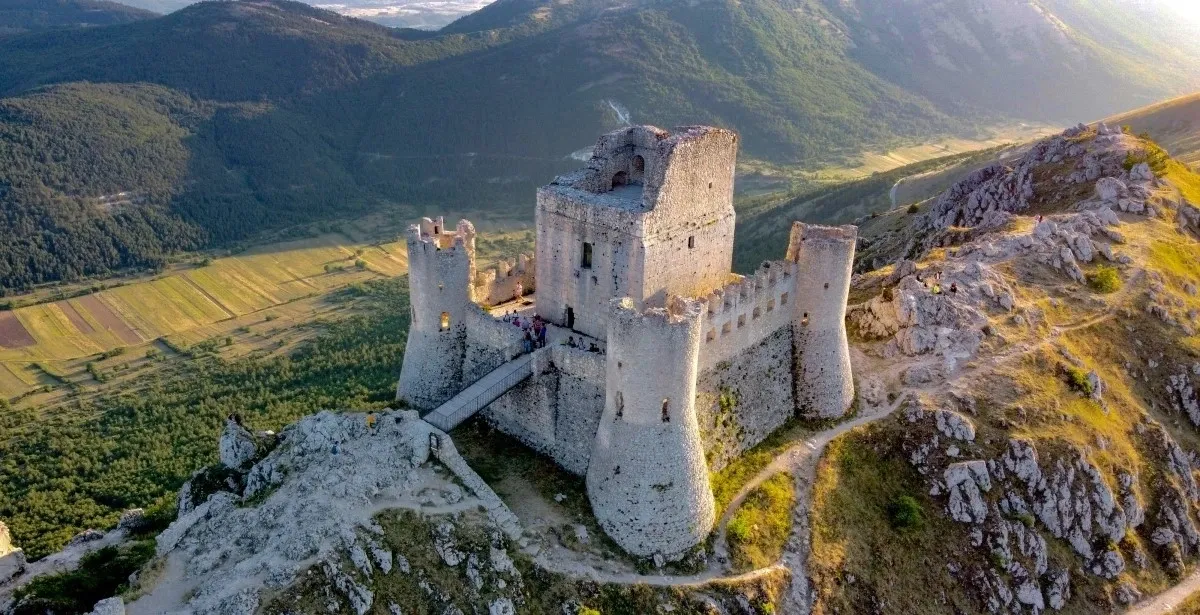Perched majestically at an altitude surpassing 1400 meters atop a ridge, the Castle of Rocca Calascio emerges as one of Italy’s most elevated fortresses. Its appeal lies not only in its rich historical legacy but also in its awe-inspiring architectural design, seamlessly blending with the natural splendor of the surrounding landscape.

History
Originally conceived solely for military purposes, this fortress boasts ancient origins dating back to the year 1000. It is attributed to Ruggero II d’Altavilla, who ordered its construction following the Norman conquest. Throughout the centuries, the castle witnessed the reign of various noble families until its mysterious abandonment. Nestled at the castle’s foothills lie the vestiges of an ancient village, a poignant reminder of the area’s storied past. In 1703, a devastating earthquake struck, causing extensive damage to both the village and the fortress.
In 1989, restoration efforts commenced, breathing new life into the castle through architectural renovations. Today, the castle welcomes visitors, serving as a gateway for trekking and mountain excursions in the Gran Sasso National Park. Beyond its historical significance, the castle serves as a focal point for exploration and outdoor adventures, beckoning enthusiasts to immerse themselves in its timeless allure.

Fashioned entirely from milk-white limestone, the Castle of Rocca Calascio boasts an impressive square layout accentuated by four cylindrical towers positioned at the corners of the expansive central keep. Entry to the fortress was facilitated through an opening on the eastern side, elevated five meters above the ground. A retractable wooden bridge, supported by sturdy stone brackets, served as the primary means of access. Originally conceived as a defensive stronghold and military observation post, Rocca Calascio occupied a strategic vantage point enabling communication with neighboring castles along the Adriatic coast via torches and mirrors.
Today
Today, Rocca Calascio stands as one of the most captivating tourist destinations in the Gran Sasso region, ensconced amidst rugged wilderness. Visitors are treated to breathtaking panoramic vistas encompassing the principal mountain ranges of the Apennines, rendering it a truly exceptional and picturesque destination.

Rocca Calascio reigns as a commanding presence within Gran Sasso Park, showcasing a remarkable ability to blend harmoniously with its natural surroundings. Exploring the castle evokes a profound sense of nostalgia, transporting visitors on a journey through time. This distinctive ambiance has rendered the fortress a favored choice as a film location.
References
Ladyhawke (USA, 1985) marked the inaugural film shot at Rocca Calascio, capturing its essence before restoration efforts took place. The following year, the iconic “The Name of the Rose” featuring Sean Connery also utilized the castle’s evocative backdrop. Additionally, Rocca Calascio graces certain scenes in the movie “The American” (USA, 2010), starring George Clooney, which was entirely filmed in the province of L’Aquila. The castle’s cinematic allure further enhances its mystique, drawing visitors into a realm where history and film seamlessly intertwine.


In close proximity to the fortress, you’ll find the Church of Santa Maria della Pietà, a unique octagonal structure erected in 1596. Legend has it that the people of Rocca Calascio built the church to commemorate their victory over a band of brigands. Despite the village’s modest size, the church boasts remarkable spaciousness and stands out as a rare example of octagonal architecture. Stepping inside, visitors are greeted with depictions of the Miraculous Virgin Mary and a sculpture depicting a fully armed St. Michael. Although now functioning as a simple oratory, the church remains a place of pilgrimage for the faithful and devout.
Apart from its religious significance, the site offers breathtaking views of the landscape, enhancing its allure with its strategic position. The Church of Santa Maria della Pietà not only holds historical and cultural significance but also serves as a testament to the resilience and faith of the community.


